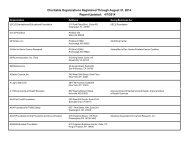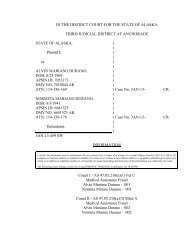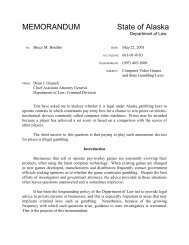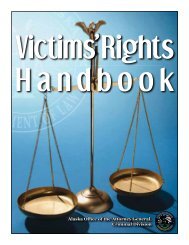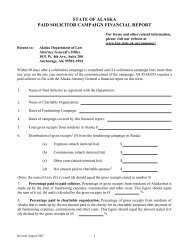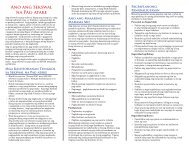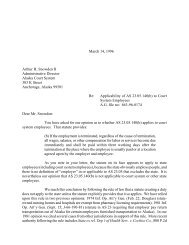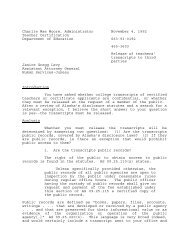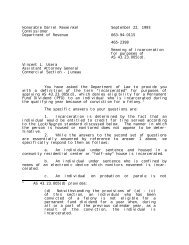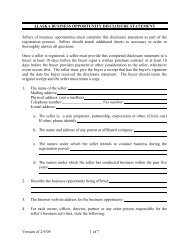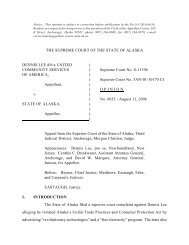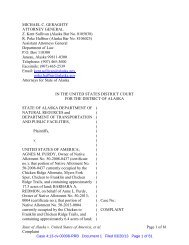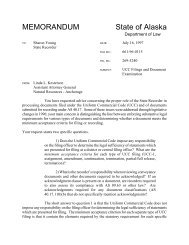Initial Report and Recommendations - Alaska Department of Law
Initial Report and Recommendations - Alaska Department of Law
Initial Report and Recommendations - Alaska Department of Law
- No tags were found...
You also want an ePaper? Increase the reach of your titles
YUMPU automatically turns print PDFs into web optimized ePapers that Google loves.
Current Status:Youth Opportunity Grant programs have been in operation (8 in TCC region), but U.S.<strong>Department</strong> <strong>of</strong> Labor funding cuts are curtailing the program.Ideal Status:a) A position <strong>and</strong>/or capacity/plan in each village to coordinate youth <strong>and</strong> family activities.b) Cooperation <strong>and</strong> collaboration in the local <strong>and</strong> state level.Structural Barriers (e.g., statutes, regulations, etc.):Lack <strong>of</strong> funding <strong>and</strong> interest.Option(s):a) Small funding sources through the state or the federal Wellness Initiative to support openinggyms after hours, craft materials, game nights, etc.b) Continued <strong>and</strong> exp<strong>and</strong>ed U.S. <strong>Department</strong> <strong>of</strong> Labor funding for Youth Opportunity grants.________________________________________________________________________Recommendation 31 (JS-22): Culturally Relevant Treatment OptionsStatement <strong>of</strong> Need:Culturally relevant treatment options are more apt to be effective with rural <strong>Alaska</strong>n <strong>of</strong>fenders.Option:Greater federal <strong>and</strong> state support for culturally relevant treatment options. The <strong>Alaska</strong><strong>Department</strong> <strong>of</strong> Corrections should collaborate with the <strong>Alaska</strong> Native Regional Non-pr<strong>of</strong>itCorporations to develop culturally relevant behavioral health treatment options.Rationale for Option:Locally-developed treatment programs which resonate with those values deeply ingrained in aculture st<strong>and</strong> a greater chance <strong>of</strong> rehabilitative success for individuals raised in that culture.Impact Statement:Enhanced rehabilitation, reduced recidivism.________________________________________________________________________Recommendation 32 (D-DS 16)Statement <strong>of</strong> problem:Inconsistent screening <strong>of</strong> DV/SA, substance abuse <strong>and</strong> dual diagnosis.Current Status:Some DV/SA programs screen for substance abuse <strong>and</strong> some substance abuse screen for DV/SAbut not consistent or st<strong>and</strong>ardized.Ideal Status:Routine screening (for the purposes <strong>of</strong> helping people in trouble identify the issues they arefacing <strong>and</strong> resources available) is incorporated in all DV/SA <strong>and</strong> chemical dependency (CD)programs.Structural Barriers (e.g., statutes, regulations, etc.):a) From the perspective <strong>of</strong> DV/SA programs: limited client confidentiality <strong>and</strong> program’sm<strong>and</strong>atory child abuse reporting make programs hesitant to document substance abuse for fear <strong>of</strong>harming victim (who therefore would never return to program).b) Resources are already stretched thin <strong>and</strong> programs cannot perform this function without morefunding.Option(s):Screening tools & interagency agreements for responding to this information are readilyavailable.<strong>Alaska</strong> Rural Justice <strong>and</strong> <strong>Law</strong> Enforcement Commission - Page 99



